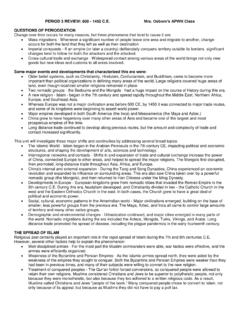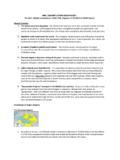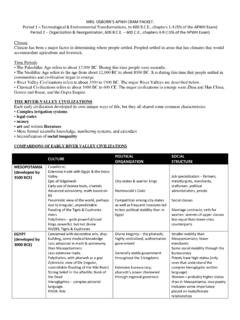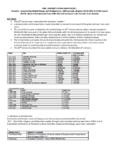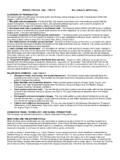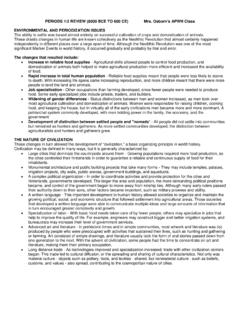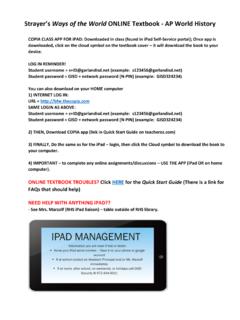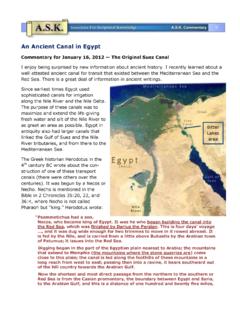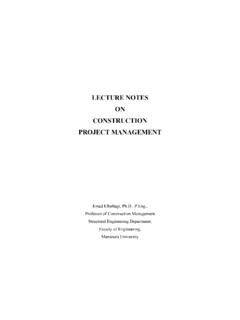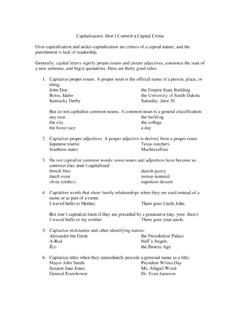Transcription of MRS. OSBORN’S APWH CRAM PACKET: Period 5 …
1 MRS. OSBORN S APWH CRAM PACKET: Period 5 industrialization & global integration , 1750-1900, chapters 23-29 (20% of APWH Exam) (NOTE: Some material overlaps into Period 6, 1900-1914) Questions of periodization: What is unique to this time Period that leads it to have its own time? The west (Europe & the ) becomes the major player in world events. Beginning in the early 1700s, Europeans truly had a hold on colonies around the world. World trading networks were dominated by the west, but they still impacted the world. Countries either have industrialization and economic development or were have nots Political, social, and economic revolutions swept the world during this time Period .
2 O Enlightenment o American and French Revolutions o Haitian Revolution o Industrial Revolution o Rise of Capitalism and Adam Smith o Unification of states (Germany, Italy, United States) o Nationalism o Imperialism o Colonialism Other major changes: 1) Suez and Panama Canals allowed for quicker travel times. 2) Technological advances in travel ships, railroads, etc., increase travel of humans and goods worldwide. 3) Huge migration movements to the Americas from Europe and Asia. 4) Industrial Revolution set up mother countries that would have factories and they needed raw materials colonies that only were used for raw materials.
3 Economic advances and development were not carried out in countries controlled by Europe. Led to lack of development that still plagues Africa, Latin America, and parts of Asia today. 5) Serf and slave systems ended in most parts of the world. 6) Political revolutions and independence movements Industrial Revolution: Began in Great Britain because of economic and political stability. Spread to the rest of Europe and the world (remember however that the Chinese had an earlier industrial revolution). Some countries had major government involvement in their industrial revolutions (Russia and Japan) while others relied upon laissez-faire and individual capitalists.
4 Overall the losers of the Industrial Revolution were the poor who gave the most labor but failed to get an equal share of the new found wealth and those in non-western countries who lost their raw materials and were discouraged from industrializing. By and large, the countries that benefited from industrialization were the ones that had the necessary components of land, labor and capital, and often government support. However, even though many other countries tried to industrialize, few had much success. For example, India tried to develop jute and steel industries, but the entrepreneurs failed because they had no government support and little investment capital.
5 An international division of labor resulted: people in industrialized countries produced manufactured products, and people in less industrialized countries produced the raw materials necessary for that production. Industrial England, for example, needed cotton, so turned to India, Egypt, and the American south to produce it for them. In many cases this division of labor led to colonization of the non-industrialized areas. As industrialization increased, more iron and coal were needed, as well as other fibers for the textile industry, and the British Empire grew rapidly in order to meet these demands. Many countries in Latin America, sub-Saharan Africa, south Asia, and southeast Asia became highly dependent on one cash crop - such as sugar, cotton, and rubber - giving them the nickname of "Banana Republics.
6 " Such economies were very vulnerable to any change in the international market. Foreign investors owned and controlled the plantations that produced these crops, and most of the profits went to them. Very little of the profits actually improved the living conditions for people that lived in those areas, and since they had little money to spend, a market economy could not develop. Despite the inequalities, the division of labor between people in countries that produced raw materials and those that produced manufactured goods increased the total volume of world trade. In turn, this increased volume led to better technology, which reinforced and fed the trade.
7 Sea travel became much more efficient, with journeys that had once taken months or years reduced to days or weeks. By 1914 two great canals shortened sea journeys by thousands of miles. The Suez Canal built by the British and French in the 1850s linked the Mediterranean Sea to the Red Sea, making it no longer necessary to go around the tip of Africa to get from Europe to Asia by sea. The Panama Canal, completed in 1913, did a similar thing in the western hemisphere, cutting a swath through Central America that encouraged trade and transportation between the Atlantic and Pacific Oceans. Demographic and Environmental Changes: Changes and Continuities in Social and Gender Structure: growing population in rural areas and enclosure of land/large-scale farming sends more labor to urban areas leading to increase in size of industrial working class in industrialized economies; young women recruited to work in textile factories; children work in factories as well until child labor laws later in the nineteenth century growing middle class due to industrialized economies' need for more white-collar workers, including teachers for public education when child labor laws enforce compulsory education.
8 Women are recruited to teach young children in public schools Victorian cult of domesticity leads middle class women or those with middle class aspirations to imitate wealthy women by not working for pay; ideal is to have a servant at home to do domestic chores Nobility lose privileges in industrialized countries Political Revolutions and Independence Movements: As the Industrial Revolution began in England; the economic changes were accompanied by demands for political changes that spread to many other areas of the world by the end of the 19th century. Two important forces behind the change were: The influence of the Enlightenment - The 1700s are sometimes referred to as the "Age of Enlightenment," because philosophical and political ideas were begun to seriously question the assumptions of absolute governments.
9 The Enlightenment began in Europe, and was a part of the changes associated with the Renaissance, the Scientific Revolution, and the Protestant Reformation, all taking place between 1450 and 1750. The Enlightenment invited people to use their "reason" using the same humanistic approach of Renaissance times. People can figure things out, and they can come up with better governments and societies. In the 1600s John Locke wrote that a ruler's authority is based on the will of the people. He also spoke of a social contract that gave subjects the right to overthrow the ruler if he ruled badly. French philosophes, such as Voltaire and Jean-Jacques Rousseau spread the new ideas to France, where they began uproar in a land that epitomized absolutism.
10 New wealth of the bourgeoisie - Ongoing commercialization of the economy meant that the middle class grew in size and wealth, but not necessarily in political power. These self-made men questioned the idea that aristocrats alone should hold the highest political offices. Most could read and write, and found Enlightenment philosophy appealing in its questioning of absolute power. They sought political power to match the economic power that they had gained. Egypt: Egypt was successful for a time in holding off the British Empire. Under the leadership of Muhammad Ali, who had fought against the Napoleonic armies, Egypt defeated the invading British army in 1807.

